During 2024-25, cargo handled at major ports increased by almost 5 per cent to 348.06 million tonnes (MT), driven by a 4.9 per cent increase in overseas cargo and 5.2 per cent increase in coastal cargo. This is a major uptick for the major ports after Covid.
On the other hand, private and state-government ports, also called non-major ports, saw a 2.8 per cent increase in their cargo over the same period. While growth in overseas cargo, at 4.29 per cent, has been competitive against major ports, a major decline in coastal cargo has left non-major ports lagging. “Major ports have been aggressively trying to capture cargo, with tariffs much lower than some of the prominent ports in their vicinity. Coastal cargo too is improving for major ports this year after no improvement this time last year,” a senior government official said. This time last year, major ports had seen almost no growth in coastal cargo, while private and state-government ports had seen their traffic increase by 21 per cent over 2021-22, with key industries switching to private ports for their coastal shipping needs.

The shift in coastal cargo movement is tilting faster in favour of major ports this financial year.
Coastal cargo traffic for major ports in August increased 10 per cent to 15.7 MT, while that for non-major ports fell to 1.3 MT.
Crude oil, fertilisers dampen the growth of private ports
According to experts, the import of crude oil, which is among the most shipped commodities at Indian ports, through private and state-government ports has moderated as several refineries like Bharat Petroleum Corporation, Indian Oil and Nayara Energy took a planned shutdown in FY25 year-to-date, which impacted exports in petroleum products.
To read the full story, Subscribe Now at just Rs 249 a month
Already a subscriber? Log in
Subscribe To BS Premium
₹249
Renews automatically
₹1699₹1999
Opt for auto renewal and save Rs. 300 Renews automatically
₹1999
What you get on BS Premium?
-
Unlock 30+ premium stories daily hand-picked by our editors, across devices on browser and app.
-
Pick your favourite companies, get a daily email with all news updates on them.
Full access to our intuitive epaper - clip, save, share articles from any device; newspaper archives from 2006.
Preferential invites to Business Standard events.
Curated newsletters on markets, personal finance, policy & politics, start-ups, technology, and more.
Need More Information - write to us at assist@bsmail.in



)